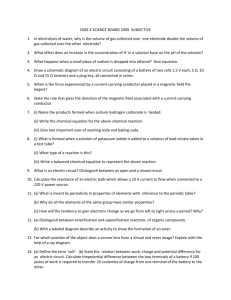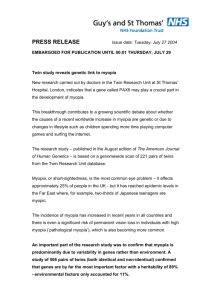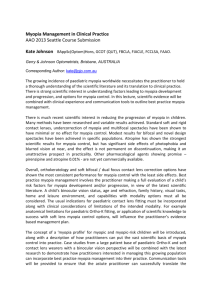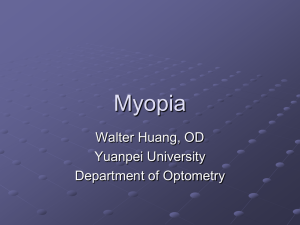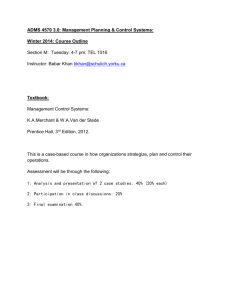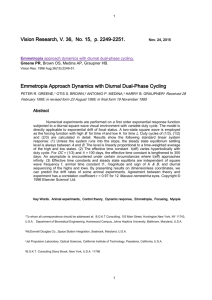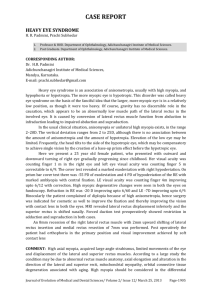Introduction
advertisement
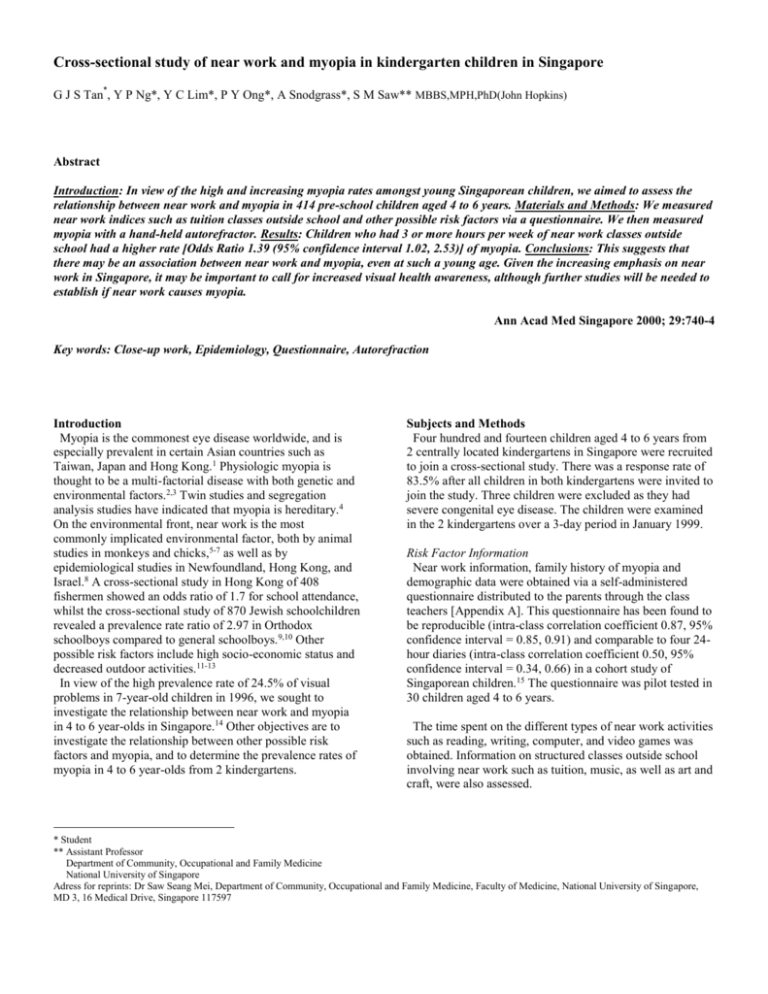
Cross-sectional study of near work and myopia in kindergarten children in Singapore G J S Tan*, Y P Ng*, Y C Lim*, P Y Ong*, A Snodgrass*, S M Saw** MBBS,MPH,PhD(John Hopkins) Abstract Introduction: In view of the high and increasing myopia rates amongst young Singaporean children, we aimed to assess the relationship between near work and myopia in 414 pre-school children aged 4 to 6 years. Materials and Methods: We measured near work indices such as tuition classes outside school and other possible risk factors via a questionnaire. We then measured myopia with a hand-held autorefractor. Results: Children who had 3 or more hours per week of near work classes outside school had a higher rate [Odds Ratio 1.39 (95% confidence interval 1.02, 2.53)] of myopia. Conclusions: This suggests that there may be an association between near work and myopia, even at such a young age. Given the increasing emphasis on near work in Singapore, it may be important to call for increased visual health awareness, although further studies will be needed to establish if near work causes myopia. Ann Acad Med Singapore 2000; 29:740-4 Key words: Close-up work, Epidemiology, Questionnaire, Autorefraction Introduction Myopia is the commonest eye disease worldwide, and is especially prevalent in certain Asian countries such as Taiwan, Japan and Hong Kong.1 Physiologic myopia is thought to be a multi-factorial disease with both genetic and environmental factors.2,3 Twin studies and segregation analysis studies have indicated that myopia is hereditary.4 On the environmental front, near work is the most commonly implicated environmental factor, both by animal studies in monkeys and chicks,5-7 as well as by epidemiological studies in Newfoundland, Hong Kong, and Israel.8 A cross-sectional study in Hong Kong of 408 fishermen showed an odds ratio of 1.7 for school attendance, whilst the cross-sectional study of 870 Jewish schoolchildren revealed a prevalence rate ratio of 2.97 in Orthodox schoolboys compared to general schoolboys.9,10 Other possible risk factors include high socio-economic status and decreased outdoor activities.11-13 In view of the high prevalence rate of 24.5% of visual problems in 7-year-old children in 1996, we sought to investigate the relationship between near work and myopia in 4 to 6 year-olds in Singapore.14 Other objectives are to investigate the relationship between other possible risk factors and myopia, and to determine the prevalence rates of myopia in 4 to 6 year-olds from 2 kindergartens. Subjects and Methods Four hundred and fourteen children aged 4 to 6 years from 2 centrally located kindergartens in Singapore were recruited to join a cross-sectional study. There was a response rate of 83.5% after all children in both kindergartens were invited to join the study. Three children were excluded as they had severe congenital eye disease. The children were examined in the 2 kindergartens over a 3-day period in January 1999. Risk Factor Information Near work information, family history of myopia and demographic data were obtained via a self-administered questionnaire distributed to the parents through the class teachers [Appendix A]. This questionnaire has been found to be reproducible (intra-class correlation coefficient 0.87, 95% confidence interval = 0.85, 0.91) and comparable to four 24hour diaries (intra-class correlation coefficient 0.50, 95% confidence interval = 0.34, 0.66) in a cohort study of Singaporean children.15 The questionnaire was pilot tested in 30 children aged 4 to 6 years. The time spent on the different types of near work activities such as reading, writing, computer, and video games was obtained. Information on structured classes outside school involving near work such as tuition, music, as well as art and craft, were also assessed. * Student ** Assistant Professor Department of Community, Occupational and Family Medicine National University of Singapore Adress for reprints: Dr Saw Seang Mei, Department of Community, Occupational and Family Medicine, Faculty of Medicine, National University of Singapore, MD 3, 16 Medical Drive, Singapore 117597 Demographic data (age, gender and socio-economic status) and parental history of myopia were obtained from the questionnaire. Myopia was more common in children who had attended 3 or more hours of near work classes outside school per week compared to those with less than 3 hours per week (Odds Ratio=1.61, 95% confidence interval = 1.02, 2.53) [Table III]. Colouring distance was not found to be associated with myopia. The distance between the children’s eyes and pencil tip was measured while the children were colouring a picture in the classroom, and the average of three readings was taken as the “colouring distance”. Both LogMAR testing as well as autorefraction were performed. The Spearman's correlation coeffecient between visual acuity and spherical equivalents for the right eye is 0.163 and the 2-sided p value was 0.001. Refractive Error Measurements LogMAR testing was performed on both eyes, with matching tests used in the majority of children. Directional tests (tumbling E) were used for the remaining minority. The two types of charts produce comparable results in children over the age of 3.16 Autorefraction was performed on both eyes for all 414 children using the Nikon K-Plus I (Nikon Co. Ltd., Tokyo, Japan). Two trained operators took 8 readings per eye, with a minimum internal validity (as reported by the autorefractor) of 8 or greater (out of a maximum of 10). The researchers measuring visual acuity, colouring distance, and operating the autorefractor were masked from each other's results and the questionnaires. The parents also completed the questionnaires without knowing the results of the testing. The mean right LOGMAR reading for myopes is 0.2738, while that for the non-myopes is 0.2224, which suggests that myopes as defined by autorefraction performed poorer on visual acuity testing. Children living in private housing, and those with less than 7 hours of outdoor activity per week had a higher prevalence of myopia [Table IV], although this was not statistically significant. Gender was not related to myopia. Children with 1 myopic parent had a prevalence rate ratio of 0.98 for myopia when compared to those with no parental history of myopia. Those whose parents were both myopic had a prevalence rate ratio of 1.08, suggesting a familial component to myopia. However, this was not significant statistically. Myopia was defined as a spherical equivalent of greater than or equal to –1.50 D in the noncycloplegic right and left eye. This allows for an average of –1.0 D difference in the non-cycloplegic reading because of residual accommodation. The prevalence rate of myopia in the two kindergartens was 28.7%. Amongst 4-year-olds, the prevalence rate was 26.8%, while it was 30.4% for 5-year-olds. Chinese had a slightly higher prevalence rate of myopia (29.8%) compared to nonChinese (16.1%). As for males and females, myopia prevalence rates were 29.1% and 28.3% respectively. Data Analysis Descriptive and univariate analyses were performed on the data using Statistical Package for Social Sciences (SPSS) version 8.0. Spherical equivalent was calculated as sphere plus half cylinder. Analysis was conducted using right eye data, as the results from the right and left eye were similar (Pearson's correlation coefficient 0.837). The p values were two-sided. Discussion The association between near work and myopia is known largely from cross-sectional studies and limited longitudinal investigations. However, few studies have dealt with myopia prevalence and onset in children below the age of 6 years. Results We examined a total of 414 subjects. There were 196 kindergarten level 1 students and 218 kindergarten level 2 students, who were mostly 4 and 5 years old respectively [Table I]. Males made up 227 (54.8%), and females 187 (45.2%) of the study population. There were 383 (92.5%) Chinese students (compared to 70.4% of the Singapore population aged 0 to 9 years).17 With regards to socioeconomic status, 354 (83.5%) lived in private housing (6 times the national average of 14%) and 60 (16.5%) lived in public housing.18 Of the parents, 294 (71%) fathers and 274 (66.2%) mothers were myopic. Screening of 48,075 seven-year-old children by the School Health Services in 1996 found that 24.47% of them had a visual acuity of worse than 6/12, making visual problems the commonest health problem amongst students in Singapore. 14 It would also appear that myopia begins early in life. 19 There are an increasing number of children attending kindergarten classes, and an increasing amount of near work being done in kindergarten as well as outside of school in the form of enrichment classes. Young children with myopia are more likely to progress to high myopia in adulthood, and this is associated with a greater risk of complications, such as retinal detachment, glaucoma and cataract.20 Of the study population, 49.0% attended tuition classes outside kindergarten hours, 38.4% music classes, 16.9% art and craft classes, and 2.4% computer classes [Table II]. The mean number of hours of classes attended outside school per week was 2.0. The mean number of hours spent outside school on nearwork per week was 4.0. Our study findings show that there may be an association between attending 3 or more hours of near work classes outside school per week and myopia. This was consistent with results obtained in a cross-sectional study done in 1993 in Hong Kong, which described a positive association (Odds 1 Ratio = 1.7) between myopia and more than 3 hours per day spent reading and writing.9 Other cross-sectional studies carried out in Newfoundland in 1980 and Israel in 1993 reached similar conclusions, as did a case-control study in Singapore in 1987, which found statistically significant associations between myopia and tasks that required prolonged and excessive accommodation.8,10 ,21 Our study showed a positive correlation between the degree of myopia and number of parents with myopia, although this was not statistically significant. Other studies have indicated that there is a familial component to myopia.4 studies have found that the results of hand-held autorefractors are comparable. Harvey E M et al performed retinoscopy and autorefraction with the Retinomax on 47 children up to 93 months of age. He found that Retinomax reproducibility averaged 0.43D, while unbiased Retinomax and retinoscopy measurements differed by an average of 0.82D, concluding that the Retinomax is a useful instrument for measuring refractive errors in children.23 Another study by Cordonnier M et al of 276 children using both the Retinomax and an on-table autorefractor after cycloplegia found no significant bias between the two types with regards to spherical equivalent (95% limits of agreement +/- 1 D).24 Our response rate of 83.5% was high, thus decreasing nonresponse bias. Because the parents of myopic children might have taken better note of their children's reading habits than parents of non-myopes, we included a greater number of objective indices of near work (such as structured tuition classes) in our questionnaire. This reduced the inevitable inaccuracies in information obtained by proxy, inherent in the responses of parents with myopic children. Recall bias was also minimised because the parents were masked to the results of the autorefraction examination. Future prospective longitudinal studies will still be needed to establish a causal relationship between near work and myopia in this age group. Similar measurements taken at birth to establish if such a state is congenital may provide further insight into the inheritance of myopia.25 Future studies should involve large sample sizes, long follow-up periods, and the use of cycloplegic subjective refraction, autorefraction and ultrasonic measurements of axial length and vitreous chamber depth in a large number of children followed up for a few years. The very young age of the subjects in the study minimised temporal bias, as there had been little time for near work habits to change in the 2 to 3 years since the development of literacy in these children. We would have thus proxies for very early reading habits that may result in myopia in the 4 to 5 year-olds in our study. Though we cannot make a definite deduction of causality between near work and myopia, our study findings suggest that nearwork activity may be related to myopia onset. The strong emphasis on academic excellence in Singapore’s educational system may call for more visual health awareness and promotion in parents with pre-school children. The prevalence of myopia in our study population was 28.7%, which was higher than the population prevalence rate of 12.2% for seven-year-old children in 1996.14 However, our study is limited to information from two kindergartens and may not be generalisable to the whole Singapore population. Acknowledgements We thank the following people for their invaluable assistance in this study: Bill Chan from Singapore Polytechnic, Optometry Centre Jean Tang from Barker Road Methodist Church Kindergarten and Natalia Tan from Nanyang Kindergarten. Lim J H, Phua M F, Chan L G, D Chong, Chua T W, Foo J P, Lai S M, Lee S Y, Leo H K, Lim G S, A Lo, Loh C, Loh Y J, A Ng, Ng B T, N Azhar, N Azhari, R Subramaniam, Seah H Y, Sim K L, Tay T C, Tee S I, Teo E H, Wang C W, Wong C Y were members of the Health Project Team, Department of Community, Occupational and Family Medicine (COFM), National University of Singapore (NUS). This study was conducted as part of a rotation of medical students to the COFM department, NUS. Our study has several limitations. No cycloplegia was administered, due to logistical difficulties and the sideeffects of cycloplegia; thus residual accommodation may still be present. Mutti DO et al found in 1994 that the use of tropicamide in children aged 6-12 added 0.74D 0.44D to the autorefraction.22 This was taken into account by using a relatively stringent criterion for myopia (-1.50 Diopters). It has been suggested that stand-alone autorefractors or retinoscopy would have been more reliable. However, two 2 TABLE I : DESCRIPTION OF STUDY POPULATION OF 414 KINDERGARTEN CHILDREN AGED 3 TO 6 YEARS FROM 2 KINDERGARTENS IN SINGAPORE IN 1999 No. (%) Age (years) 3 2 (0.5) 4 188 (45.4) 5 218 (52.7) 6 6 (1.4) Gender Male 227 (54.8) Female 187 (45.2) Race Chinese Non-Chinese 383 (92.5) 31 (7.5) Housing type 1-3 room HDB flat 4 room HDB flat 9 (2.2) 51 (12.3) Condominium/Private apartment 167 (40.3) Landed property 187 (45.2) Parental history of myopia No myopic parent 61 (14.7) 1 myopic parent 135 (32.6) 2 myopic parents 210 (50.7) Father myopic 294 (71.0) Mother myopic 274 (66.2) Mean (SD) Outdoor activity (hours/week) 5.11 (4.7) 1 TABLE II : DESCRIPTION OF NEAR WORK INDICES OF KINDERGARTEN CHILDREN AGED 3 TO 6 YEARS FROM 2 KNDERGARTENS IN SINGAPORE IN 1999 Characteristics of near work indices No. (%) Type of near work classes outside school Tuition 203 (49.0) Music 159 (38.4) Art and craft 70 (16.9) Computer 10 Mean All near work classes outside school (hours/week) (2.4) (SD) 2.0 (2.3) Reading and writing 1.5 (1.1) Computer 0.6 (0.6) All near work activities (reading, writing, etc) 4.0 (1.9) 23.6 (4.5) Type of near work activities (hours/day) Distance of object from eyes while colouring (cm) 2 TABLE III : ASSOCIATION OF INDICES OF NEAR WORK WITH MYOPIA IN STUDY POPULATION OF CHILDREN AGED 3 TO 6 IN 2 KINDERGARTENS IN 1999 Myopes (n=119) Characteristics of near work indices No. Non-myopes (n=292) (%) No. (%) Odds ratio 95%CI* 1.61 (1.02,2.53) 0.97 (0.59,1.60) Total duration of nearwork classes outside school Less than 3 hour per week (n=289) 75 (26.0) 214 (74.0) Equal or more than 3 hour per week(n=122) 44 (36.1) 78 (63.9) Less than 26.7cm(n=315) 91 (28.9) 224 (71.1) Equal or more than 26.7cm(n=97) 28 (28.9) 69 (71.1) Colouring distance *CI = Confidence interval TABLE IV : CHARACTERISTICS OF MYOPIC AND NON-MYOPIC CHILDREN IN 2 KINDERGARTENS IN SINGAPORE IN 1999 Non95% Myopes myopes Prevalence Confidence No. (%) No. (%) rate ratio Intervals Gender Male(n=227) 66 (29.1) 161 (70.9) 1.00 Female(n=187) 53 (28.3) 134 (71.7) 0.97 15 (25.0) 45 (75.0) 1.00 104 (29.4) 250 (70.6) 1.25 No parent(n=61) 17 (27.9) 44 (72.1) 1.00 One parent(n=135) 37 (27.4) 98 (72.6) 0.98 0.50,1.92 Two parents(n=210) 62 (29.5) 148 (70.5) 1.08 0.58,2.04 Less than 7 hours per week(n=295) 88 (29.8) 207 (70.2) 1.00 Equal or more than 7 hours per week(n=117) 30 (25.6) 87 (74.4) 0.81 0.63,1.48 Housing type Government housing(n=60) Private housing(n=354) 0.67, 2.33 Parental history of myopia Outdoor activity 3 0.50, 1.32 Appendix A Selected items from the questionnaire: Average number of hours per day (to the nearest half-hour) Type of Activity 1. Reading, writing, drawing & colouring 2. Computer use (including computer games & internet use) ________ hours PER DAY ________ hours PER DAY My child is attending these CLASSES OUTSIDE SCHOOL HOURS: Average number of Type of classes hours per week 3. Tuition classes ______ hours PER WEEK 1 Yes 2 No 4. Music classes ______ hours PER WEEK 1 Yes 2 No 5. Art & craft classes ______ hours PER WEEK 1 Yes 2 No 6. Computer classes ______ hours PER WEEK 1 Yes 2 No References 1. Albert D M, Jakobiec F A, editors. Principles and Practice of Ophthalmology: Clinical Practice. Philadelphia, 1994:878. 2.Theodore G. Primary Care Optometry: Anomalies of Refraction and Binocular Vision. Boston, 1996:76-9. 3. Curtin B J. The Myopias: Basic Science and Clinical Management. Philadelphia: Harper and Row, 1985:61-3. 4. Sorsby A, Sheridian M, Leary G A. Refraction and its components in twins. Special Report Series No 303, Medical Research Council, London, Her Majesty’s Stationery Office, 1962. 5. Wiesel T N, Raviola E. Myopia and eye enlargement after neonatal lid fusion in monkeys. Nature 1977; 266:66. 6. Young F A. The effect of restricted visual space on the primate eye. Am J Opthalmol 1961; 52:799. 7. Wallman J, Turkel J, Tracatman J. Extreme myopia produced by modest change in early visual experience. Science 1978; 201:1249. 8. Bear J C, Richler A, Burke G. Refraction, nearwork and education. A population study in Newfoundland. Acta Ophthalmol (Copenh) 1980; 58:468-478. 9. Wong L, Coggon D, Cruddas M, Hwang C H. Education, reading, and familial tendency as risk factors for myopia in Hong Kong fishermen. J Epidemiol Community Health 1993; 47:50-3. 10. Zylbermann R, Landau D, Berson D. The influence of study habits on myopia in Jewish teenagers. J Pediatr Ophthalmol Strabismus 1993; 30:319-22. 4 1. Sperduto R D, Seigel D, Roberts J, Rowland M. Prevalence of myopia in the United States. Arch Ophthalmol 1983; 101:405-7. 12. Angle J, Wissman DA. The epidemiology of myopia. Am J Epidemiol. 1980; 111:220-8. 13. Au Eong K G, Tay T H, Lim M K. Race, culture and myopia in 110,236 young Singaporean males. Sing Med J 1993; 34:29-32. 14. Primary Health Services, Ministry of Health. School Health Service - Annual Report 1996; 8. 15. Saw S M, Nieto F J, Katz J, Chew S J. Estimating the magnitude of close-up work in school-age children: a comparison of questionnaire and diary instruments. Ophthalmic Epidemiology 1999;6:291-301. 16. Optometric instrumentation, David B Henson, 2nd Edition : 220 17. Department of Statistics, Singapore. Yearbook of Statistics, Singapore, 1999; 4 18. Department of Statistics, Singapore. Yearbook of Statistics, Singapore, 1995; 12,22,254. 19. Primary Health Services, Ministry of Health. School Health Service - Annual Report 1996; 42. 20. Law N M, Chew S J, Ritch R, Thompson H W, Beuerman R W. Survey of refraction in a Chinese population shows that myopia severity can be predicted from its age of onset. Invest Opthalmol Vis Sci 1992; 33:709. 21. Ling S L, Chen A J, Rajan U, Cheah W M, et al. Myopia in ten year old children – a case control study. Sing Med J 1987; 28(4):288 -292. 22. Mutti D O, Zadnik K, Egashira S, et al. The effect of cycloplegia on measurement of the ocular components. Invest Opthalmol Vis Sci 1994; 35:51527. 23. Harvey E M, Miller J M, Wagner L K, Dobson V. “Reproducibility and accuracy of measurements with a hand held autorefractor in children”. Br J Opthalmol, 1997; 81:941-8 24. Cordonnier M, Dramaix M, Kallay O, de Bideran M. “How acurate is the handheld refractor Retinomax® in measuring cycloplegic refraction: a further evaluation”. Strabismus, 1998; 6:133-42 25. Zadnik K, Satariano W A, Mutti D O, Sholtz R I, Adams A J. “The effect of parental history of myopia on children’s eye size”. JAMA, 1994; 271:1323-7. 5
